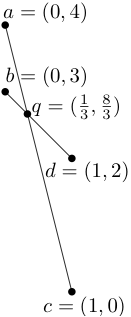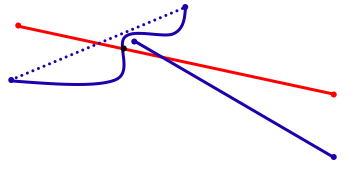The Challenge
 We usually think of computers as good at mathematical calculations but, in fact,
they often allow a small amount of error so that they can go fast: 1/3 might be
stored as just the first 16 digits of 0.3333…, , so that 3*(1/3) < 1. This can
cause problems when numerical calculations are used to figure out geometric
relationships: rounding the coordinates of the point q actually takes it off
the lines ac and bd that define it!
We usually think of computers as good at mathematical calculations but, in fact,
they often allow a small amount of error so that they can go fast: 1/3 might be
stored as just the first 16 digits of 0.3333…, , so that 3*(1/3) < 1. This can
cause problems when numerical calculations are used to figure out geometric
relationships: rounding the coordinates of the point q actually takes it off
the lines ac and bd that define it!
You can sometimes see this in video games – your character might be able to
put a hand inside a wall because the computer is allowing a small error. And
while you may enjoy the possibility to “cheat” in a video game, you would not
want the software in an airplane or a surgical robot to violate the laws of
nature in this way. Yet most techniques to avoid these errors require special
programming and slow down both the development and execution of computer programs.
The Approach
Algorithm designers try to minimize use of resources of time and memory space. Our
work considers arithmetic precision as another resource, and minimizes the degree
of polynomials used in the geometric tests or predicates that are applied.
For example, consider the problem of overlaying maps of roads and county boundaries.
If the input is 2D points with b bit coordinates, then testing if two line segments
intersect is degree 2 (double precision) but actually computing the intersection
is a rational polynomial with degree 3 over degree 2. Some algorithms that compute
intersections also sort them by x-coordinate, which takes degree 5, or
five-fold precision. (Since computer hard-ware usually provides fast double
precision only, it is not surprising that occasional errors occur when you need
quintuple precision!)

Developing fast algorithms with limited precision requires creativity. If you
restrict yourself to degree two, you can determine whether two lines intersect,
but you learn very little about where the intersection actually occurs.
Treating precision as a limited resource brings to our attention the high
cost of sophisticated geometric operations. Moreover, it allows us to better
guarantee that implementations of our algorithms are not only efficient, but also correct.